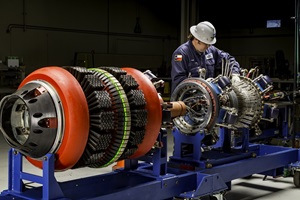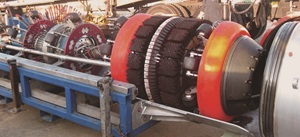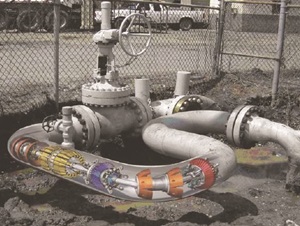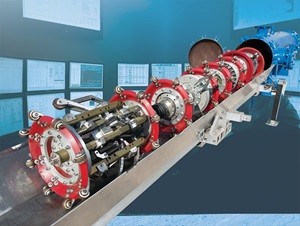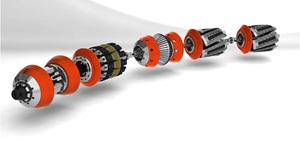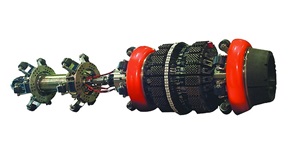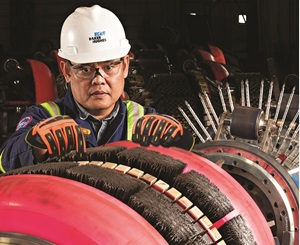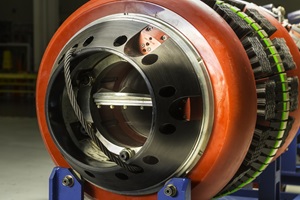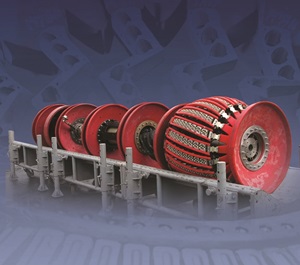Smart Pigs, Safe Pipes (Part 2): New inspection technology doubles down on sensors
Tools tackle metal loss, corrosion with an extra degree of precision, ultra-high-definition data
There’s powerful magnetic attraction. And then there’s powerful magnetic detection.
Enbridge focuses heavily on prevention to keep our crude oil pipeline network safe. In-line inspection (ILI) tools—or “smart pigs,” to use industry jargon—are highly complex pieces of machinery that use advanced imaging technology to inspect our pipes inch by inch.
And in recent months, one of our partners in prevention—Baker Hughes Inc., the world’s premier pipeline inspection services company—unveiled an extra-strong magnetic magnifying glass, so to speak, for an extra degree of precision.
Baker Hughes’ new VECTRA HD technology, launched in February, doubles down on the number of sensors in its Magnetic Flux Leakage (MFL) inspection tools. The result is a more accurate picture than ever of pipeline fitness.
“Metal loss and corrosion can be caused by a number of factors,” says Geoff Hurd, a manager of process and pipeline services for Baker Hughes. “There’s gouging and third-party strikes from construction or farming activity, which can damage pipeline coatings and the pipe steel itself.
“There may be flaws during the manufacturing process, causing varying wall thicknesses,” he adds. “And sometimes, multiple protection systems in place are challenged in what can sometimes be a harsh operating environment.
“Ultimately,” says Hurd, “VECTRA HD provides early detection of any issues—with pinpoint locations of the smallest instances of metal loss and complex corrosion.”
Enbridge has entrusted Baker Hughes with robust ILI-based pipeline diagnoses since 1998. In that time, Baker Hughes has performed more than 400 pipeline inspections across Enbridge’s pipeline network, producing more than 70,000 kilometers’ worth of inspection data.
Image gallery: Smart Pigs, Safe Pipes (Part 2)
Baker Hughes’ VECTRA HD technology has nearly twice as many triaxial sensors—that is, sensors measuring potential metal loss in axial, radial and circumferential directions—per square inch of pipe.
Moving at about 4.5 meters a second through gas, oil or refined products pipelines, these VECTRA HD tools send back ultra-high-definition data indicating even the smallest features that may require further inspection.
“Basically, we’re talking about a better view of the pipeline all-around. The ILI tool, and our analysts examining the data, are seeing what others can’t,” says Hurd.
Maintaining the fitness of our pipes is key to ensuring a safe network. Enbridge has never experienced an internal corrosion failure on our mainline network, and we take multiple precautions to keep it that way, including:
- Robust pipeline coatings;
- Cathodic protection, the application of a low-level electrical current to all surfaces of the pipeline;
- Enforcing stringent quality standards for every batch of oil entering our network;
- Maintaining a high flow rate on our transmission lines; and
- Adding corrosion inhibitors to the oil in our lines.
Accordingly, our primary concern is the exterior walls of our pipes, and their susceptibility to third-party damage—one of the leading causes of pipeline leaks.
“We have different tools for various situations. If it’s a thicker pipe, we use specially designed tools that have the necessary magnetic strength to ensure we can confidently detect any corrosion on the outside of the pipe,” says Hurd.
Check out our previous instalments of the Smart Pigs, Safe Pipes series:
Part 1: Getting down to the finer details
Check back with the @enbridge blog channel for future instalments of our Smart Pigs, Safe Pipes series.




